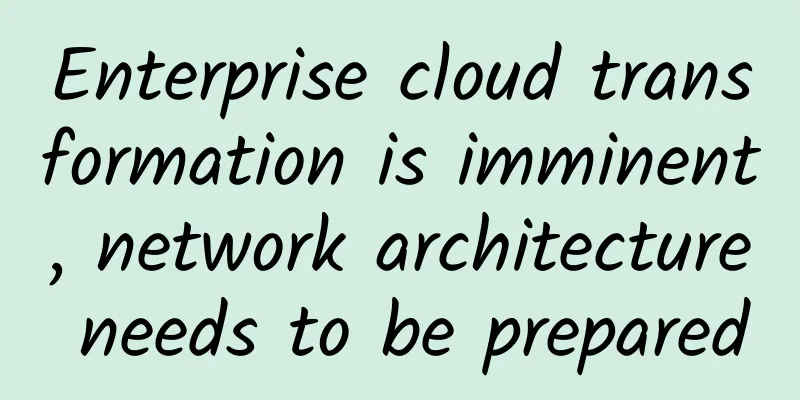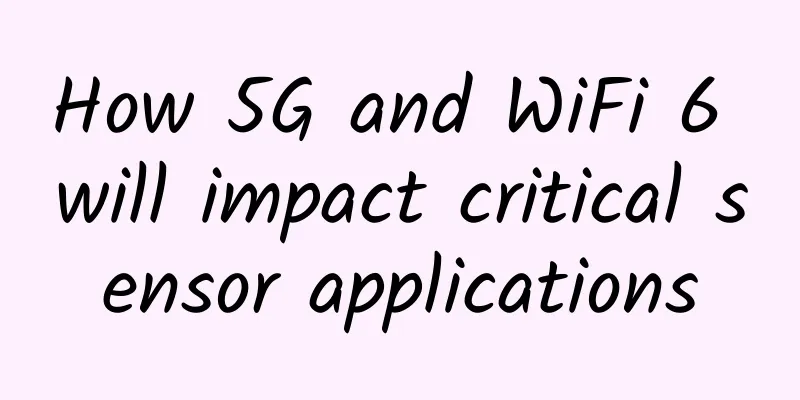Enterprise cloud transformation is imminent, network architecture needs to be prepared

|
[51CTO.com original article] The rapid development of cloud computing, SDN, mobile Internet and big data technology has brought great opportunities for enterprise development. Many enterprises have chosen digital transformation and migrated their businesses to the cloud. However, for those enterprises that are about to embark on the road of transformation, they need to be fully prepared to ensure the smooth completion of the transformation.
The network is an important support for the cloud computing infrastructure and the basis for all application logic and data transmission in cloud computing. Therefore, if enterprises want to achieve cloud transformation, reduce costs and improve efficiency, and maximize the advantages of cloud computing, the first thing to consider is network architecture transformation. However, the network architecture of many enterprises is not very suitable for cloud transformation, and the road to cloudification is not smooth. Their network architecture urgently needs to be changed to adapt to their own transformation needs. Enterprise cloud transformation places high demands on network architecture At present, in the process of enterprise cloud transformation, more and more IT managers realize that only with a good network architecture can the overall level of enterprise digitalization be improved and the enterprise's cloudification be truly successful. So, how should the enterprise network architecture be transformed so that the network does not become a bottleneck in the cloudification process? Enterprises need to simplify the network architecture to make it intelligent, flexible, secure and open, support the elastic expansion capabilities of cloud computing, and adapt to the allocation of dynamic application resources. The network architecture needs to support large-scale virtualization environments, achieve efficient access to cloud computing resources, and ensure security from the cloud to various terminal devices. First, the entire network architecture is flattened, and gradually simplified from a multi-layer architecture to a single-layer architecture, thereby reducing the number of devices in the network and the complexity of networking, and reducing operation and maintenance and energy consumption costs. Secondly, the new network architecture needs to realize intelligent identification of user identity, terminal type, etc., and dynamically adjust network resources to optimize support for applications. At the same time, it needs to do a good job in network security protection for the entire data transmission process from terminal to access network, transmission, and data center, and realize security protection for sensitive data from large-scale virtualized computing environment to hybrid access between clouds and on enterprise terminals. Thirdly, on the premise of meeting current application needs, it should also meet the cloud computing needs of enterprises in various stages in the future. Therefore, the enterprise network needs to always have the ability to expand on demand and technical foresight, which requires enterprise managers to have good foresight and fully understand their own business characteristics in the network architecture transformation, and then choose the cloud architecture model. Juniper Networks empowers enterprise cloud transformation As a well-known provider of network products and solutions, Juniper Networks has been committed to providing automatic, scalable and secure network products and solutions. In recent years, Juniper Networks has continuously launched new technology products to help service providers and enterprises simplify cloud network architecture. Recently, Juniper Networks launched Cloud-Grade Networking, which introduces a new mechanism for the architecture, delivery, and security protection of applications and services. It can integrate telemetry, automation, and machine autonomous learning capabilities to further overcome the technical challenges of cloud transformation. According to reporters, Cloud-Grade Networking includes four major principles: platform first, decomposition, autonomous networks, and ubiquitous software-defined secure networks (SDSN). These principles enable networks in any location to achieve the agility and operational scale they deserve, thereby better promoting innovation. With new orchestration and automation capabilities, this approach also combines carrier-grade coverage and reliability with enterprise-grade control and availability, providing both traditional and personalized services while reducing costs and complexity in a secure manner. In addition to these new products and solutions, in terms of public cloud, Juniper Networks provides products and solutions represented by QFabric and vGW virtual gateway, which can support large-scale virtualized environments and effectively manage multi-tenant clouds, thereby ensuring that public cloud service providers can obtain the best service capabilities and operation and maintenance efficiency. In terms of private cloud, Juniper Networks has flexible solutions represented by QFX, EX, and SRX, which are suitable for virtualization, simplified architecture, and reduced energy consumption requirements of private clouds of various sizes. In the case of hybrid cloud, Juniper Networks will organically combine the advantages of public cloud and private cloud based on leading routing, identity and permission management, and provide enterprises with a seamless cloud computing network experience in combination with SSO requirements. In addition, Juniper Networks also has the Open Cloud Interconnect solution for public cloud, private cloud and hybrid cloud environments. This solution uses industry-leading technologies in routing, switching, packet optics, network management and SDN to provide customers with flexible and open data center network architecture strategies, improve network automation, visualization and controllability, and help enterprises simplify network operations and maintenance while accelerating cloud service delivery capabilities. [51CTO original article, please indicate the original author and source as 51CTO.com when reprinting on partner sites] |
<<: Analyzing the technology behind short videos and reopening the battle against CDN
>>: Symantec releases new CISO survey: Cloud becomes the next starting point for cybercrime
Recommend
What you need to know about HTTP protocol
Today we will analyze the HTTP protocol, which is...
5 years, $50 billion! In order to catch up with China, they call on Biden to speed up the construction of 5G
The American Forbes website recently published an...
Are the price increases for mobile phones and broadband services caused by 5G construction?
Over the past year, mobile phone charges have inc...
Report: By 2025, 5G mobile phones will account for more than 50% of smartphone sales revenue
[[417906]] A new study by Juniper Research found ...
Wi-Fi Alliance announces Wi-Fi 6 as new logo
Nowadays, Wi-Fi has become an indispensable part ...
Why is the world crazy about blockchain? Because of a "wealth code"
In 450 BC, Nehemiah, an official of the Persian E...
How to change ssh port in CentOS7.*
I checked the port modification records in the si...
Overview of 5G Industry Terminal Development
With the continuous development of the fifth gene...
It turns out that the HTTP protocol is so simple! Understand HttpServletRequest in one article
1. Introduction to HttpServletRequest The HttpSer...
How the wireless network market will develop in 2022
A wireless network is a computer network that re...
2G/3G will be phased out soon, and NB-IoT will start to take over
With the upcoming decommissioning of 2G/3G networ...
BandwagonHost has launched CN2 GIA at a special price starting from $74.5/year, with 1GB/20G SSD/1TB@1Gbps/multiple nodes available
Bandwagonhost has launched (restocked) a special ...
Shen Bin from CAICT: 5G factories promote high-quality development of "5G+Industrial Internet"
In August 2022, the Ministry of Industry and Info...
Where is the future in the post-5G era?
According to the latest news from the 3GPP offici...
[Mid-Autumn Festival/National Day] CUBECLOUD: 30% off for Lite series/15% off for Pro series, available in CN2 GIA Hong Kong/CN2 GIA Los Angeles
CUBECLOUD (Magic Cube Cloud) has launched a promo...






![[Black Friday] HostKvm Hong Kong Signature VPS is permanently 40% off, top up $50 and get $5 free](/upload/images/67cac22cabdbc.webp)


